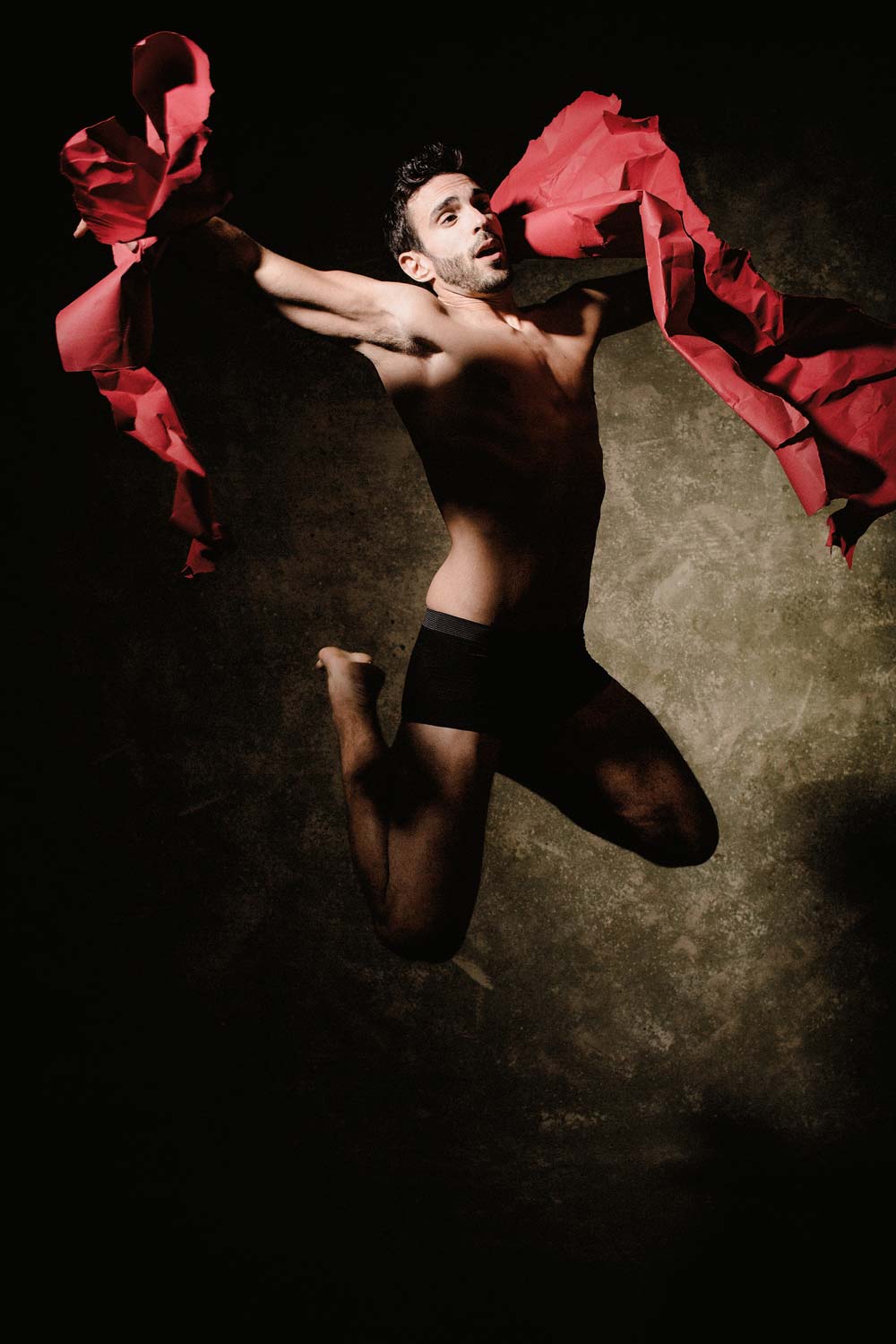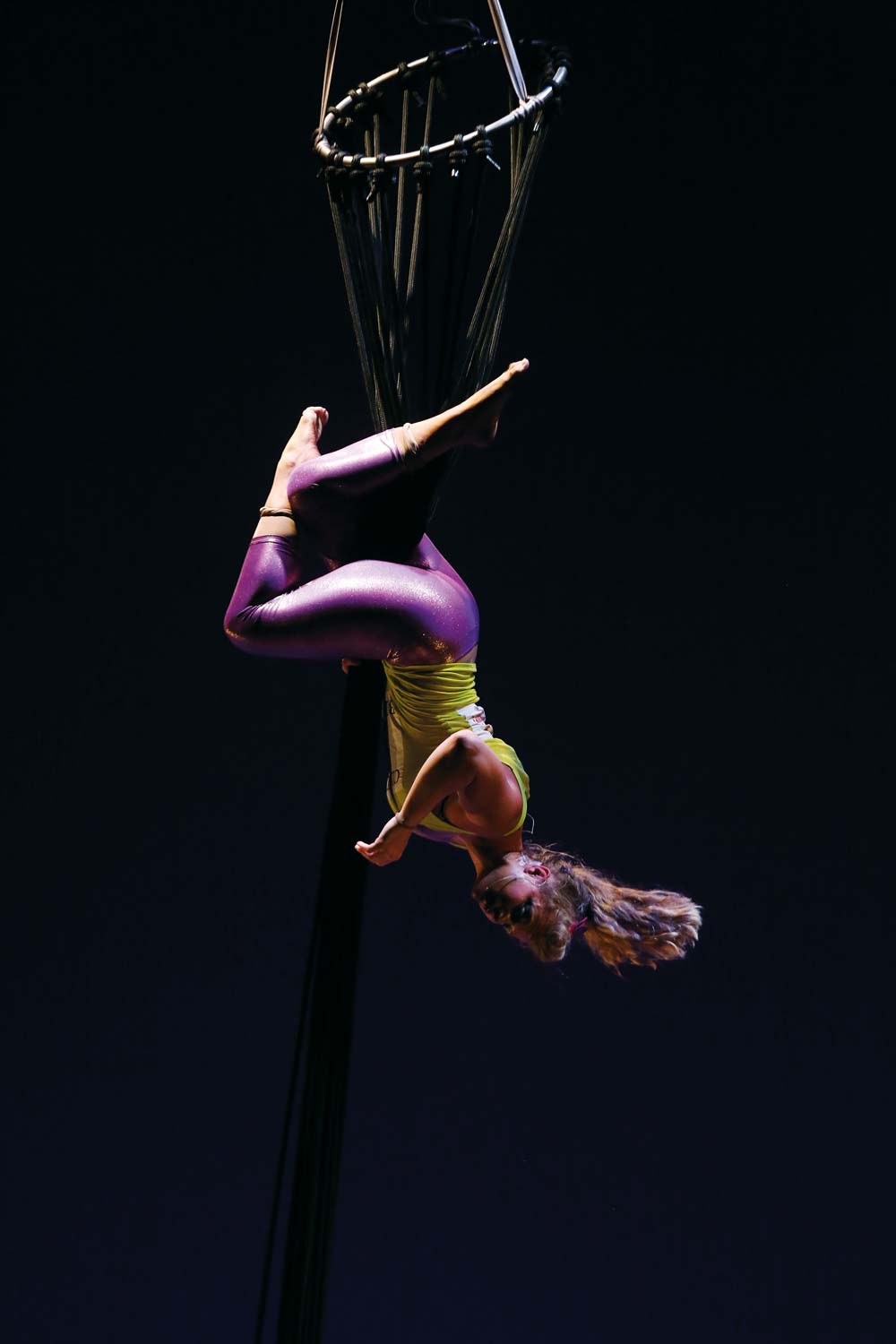Once upon a time, so the axiom went, everybody wanted to run away and join the circus. These days, though, no one has to run away; circus is becoming more of a possibility in one’s own backyard. Circus arts organizations are popping up everywhere, and everyone from established theatrical troupes to fringe performers are incorporating acrobatics and circus arts in their work and creating theatrical spectacles. This growing trend has created a demand not only for practitioners of circus arts, but also trainers and directors who specialize in these arts from all over the country.
Jeff “Tree” Anderson is a coach, choreographer, and director who cofounded Clan Destiny Circus, a circus theatre in Asheville, N.C. He firmly believes that “everyone deserves circus.” Unable to compete with Cirque du Soleil with its huge sets, costumes, and music, Anderson and his DIY circus create workshops for ordinary people to participate in activities ranging from pole dancing to acrobatics and human pyramids, to programs where parents can learn to “fly” their kids properly. Anderson’s theatrical work includes teaching mime to show how a face or body moves when it is happy or sad.
“What does an angry face/sad body look like?” Anderson asks rhetorically. “The responses to these exercises are mental, physical, and emotional.”
He continues, “Once we have mime, we tell stories. One such performance is the cycle of the Hindu Creation Myth, or another piece, Day in the Life Mechanica, about how circus can liberate you.” His shows feature silk elements and aerials, as well as hula hoopers and spinning fire staffs.
Anderson studied mime and theatre in college and was inspired to create his acrobatic mime troupe in the late 1990s. “The genesis for all of this comes from Mummenschanz and Vsevolod Meyerhold, a contemporary of Stanislavski,” he explains. “He developed biomechanical theatre, which is a physical representation of complex internal emotional concepts, and he built these crazy sets with slides and intense physical work activities.
“What I find is that people have muscle memory from years of play and putting their butt over their head,” Anderson continued. “The play and the sense of adventure and creating a character hits on a deep childhood thing—everyone has an aspiration to be a famous performer. Doing something like circus speaks to that.”

Peter Andrew Danzig is an actor and personal trainer, as well as the founder of Theatrical Trainer, a Philadelphia-based company designed to condition actors, dancers, and circus professionals to enhance their performance. His company provides one-on-one coaching to prepare an actor for a specific role. He leads workshops for casts and teaches new skills in movement coaching, choreography, and physical theatre.
Danzig realized that the landscape for physical theatre in Philadelphia was growing quickly, with independent companies and large resident theatres incorporating acrobatics, light tumbling, and circus arts, as well as general extreme physicality and even Parkour into their productions. His training is based on kinesiology, biometrics, and each individual’s physiology.
“There are no longer actors who just dance—there are actors who do circus silk work, and tumbling, and backflips, and are extreme physical contortionists,” Danzig explained. “But most actors are not specifically trained one way or another to address the needs of the role.” His company, then, was created to help “prepare character movement,” incorporating circus arts and physicality.
Indeed, it is common now for directors to ask performers if they have a front roll or know other forms of tumbling. Danzig recalls, “On one of my first jobs, I was asked to stand on someone’s shoulders and create shapes. I had danced my whole life, but this was something new. It was out of my repertoire.”
Learning the skills is one thing, but just as important is learning to stay in proper condition to do them on a theatrical schedule; singing, climbing, or dancing 7-8 times a week for 2-3 hours at a time means burning calories at a rate equivalent to that of a soccer player. To keep up one’s stamina, Danzig recommends conditioning exercises that range from planks and V-ups to leg lifts and weight-bearing activities that engage the body’s core.
“Actors need to think of themselves as athletes,” said Danzig. “Circus works with biometrics, so we want them to be able to bound and jump and land, and use multi-plane arc movement to address that kind of work. There needs to be upper body strength.”
A recent example of his work: He taught the cast of Luna Theater Company’s all-female production of Animal Farm some light tumbling and acrobatic work, including building a windmill with their bodies.
“You can’t just go to a gym and do crunches or a cardio class—it’s a different kind of conditioning and a rigorous skill set,” Danzig explains. “If the actor is climbing silks, push-ups and upper body strengthening and push-and-pull activities are much better than lifting weights and doing bicep curls.”

Also in the City of Brotherly Love is Damon Bonetti, founding artistic director of the Philadelphia Artists’ Collective, a theatre company that has begun to incorporate circus. Their upcoming staging of He Who Gets Slapped (March 30–April 10), adapted by Walter Wykes from Leonid Andreyev’s original, is set in a seedy French circus in the 1920s, although the actual circus is only heard from offstage. Still, Bonetti—whose background is in more traditional theatre—plans to incorporate circus arts into the production. He has partnered with the Philadelphia School of Circus Arts and hired performers from local companies such as the Headlong Dance Theater and Pig Iron Theatre Company, who are adept at physical work.
Bonetti plans to use circus and physical arts to create interludes at the top and in between scenes that will involve live music and establish location, as well as create flashbacks that further or foreshadow the plot and character development. “The actress playing the show’s lion tamer bought a bullwhip and is going to learn the skills involved with cracking it,” Bonetti boasts.
While this is Bonetti’s first production with circus arts, he already is open to incorporating more acrobatics into his theatre. “Here in Philly, we have had such a rich tradition of physical performance,” Bonetti said. “Ten years ago, it was very divided between physical and classical text; they didn’t mix much. But those bridges have come down, so that you’re not just going to see a classic performance done in a traditional way. Even if it’s not a super-movement piece, you’re going to see more expressions featuring the body; it’s more visceral. With this particular play, it worked out perfectly.” Indeed, though he admitted that “it’s a tease that we don’t get to see the performance of circus,” by incorporating “interludes that are organic in the story,” he’s made circus integral to the storytelling.
Caitlyn Larsson is the director of Fit to Fly, a company that independently contracts with theatres to provide “circus to real people.” A self-described “fixer,” Larsson travels all over the world to work with companies that want to incorporate circus in their productions.
“I come in early and start with nothing, or come in late and fix what they already have—make it presentable, make it pretty, make it understandable to the audience, tell a story, give it life, and make it more dimensional,” she explains. “I get people who can dance or do aerial—not both—and I open them up to doing more to show them how amazing they can be.”
Larsson’s work involves creating trust and a safe space for this kind of play. She tailors her work to individuals and groups, and trains performers for circus routines at their level.
“The real work is bringing character to a piece—gestures and facial expressions—and bring that to the story,” says Larsson. “If your character is climbing a fabric, why does he do that? What does he want at the top of it?”
Part of her craft is guiding actors by talking about the world of the play and creating that world’s distinctive rules.
“I have directorial training, so I pick out what they are trying to express,” she says. “People hold things they create dear to their hearts, and theatre doesn’t always work that way. You sift through the parts that work…I show them they have a good instinct when they have an idea or a suggestion that doesn’t quite work, but I can also take them in a different direction; it’s remolding the tidbits.”
Larsson has also performed as an aerialist and done volunteer work with Clowns Without Borders, a humanitarian organization. Hers is a hectic life, but Larsson acknowledges that the pros outweigh the cons.
“I’m OK not having many belongings,” she says. “I have three suitcases of circus paraphernalia and one suitcase of clothes. I don’t own property or have a lease. I’m a vagrant; I love to travel.” (She did point that she has a retirement account, but “no guarantees when I get old.”)
It turns out that some people do still run away with the circus.”
Gary M. Kramer is a freelance writer.


